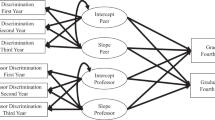Abstract
Although corrections researchers have examined criminal justice students’ attitudes toward offender punishment and the death penalty, they have overlooked the important area of inmate privileges. Using data collected from 570 students enrolled at four different Southern universities, this study examines attitudinal differences between criminal justice and noncriminal justice majors in terms of providing inmates with psychological counseling, college education programs, television, cigarettes, weightlifting, and conjugal visits. No statistically significant attitudinal differences emerged between criminal justice and noncriminal justice majors.
Similar content being viewed by others
References
Applegate, B. K. (2001). Penal austerity: Perceived utility, desert, and public attitudes toward prison amenities.American Journal of Criminal Justice, 25, 253–268.
Bohm, R. M. (1990). Death penalty opinions: A classroom experience and public commitment.Sociological Inquiry, 60, 285–297.
Bryant, P. T., & Morris, E. (1998). What does the public really think? A survey of the general public’s perceptions of corrections yields some surprising results.Corrections Today, 59, 26–28, 79.
Bureau of Economic and Business Research. (1997). Corrections in Florida: What the public, news media, and department of corrections staff think. Retrieved April 24, 1998, from http://www.dc.state.fl.us
Carlan, P. E., & Byxbe, F. R. (2000). The promise of humanistic policing: Is higher education living up to societal expectation?American Journal of Criminal Justice, 24, 235–246.
Doble, J., Higgins, D., Begasse, J., & Fisher, C. (1995). Crime and corrections: The views of the people of North Carolina. Retrieved February 9, 2003, from http:// www.dpc.state.nc.us/news/February 9, 2003oblerep.htm
Dull, R. T., & Wint, A. V. N. (1997). Criminal victimization and its effect on fear of crime and justice attitudes.Journal of Interpersonal Violence, 12, 748–759.
Durham, A. M. (1992). Observations on the future of criminal justice education.Journal of Criminal Justice Education, 3, 35–52.
Farmer, J. F. (1996). Wrestling with what to include in a new criminal justice curriculum.ACJS Today, 15, 1, 3, 9.
Farnworth, M., Longmire, D. R., & West, V. M. (1998). College students’ views on criminal justice.Journal of Criminal Justice, 9, 39–57.
Finn, P. (1996). No-frills prisons and jails: A movement in flux.Federal Probation, 60, 35–44.
Flanagan, T. J., & Longmire, D. R. (Eds.). (1996).Americans view crime and justice: A national public opinion survey. London: Sage Publications.
Giacopassi, D., & Vandiver, M. (1999). University students’ perceptions of tobacco, cocaine, and homicide fatalities.The American Journal of Drug & Alcohol Abuse, 25, 163–172.
Inmate privileges and fees for service (2002).Corrections Compendium, 27, 8–26.
Johnson, W. W., Bennett, K., & Flanagan, T. J. (1997). Getting tough on prisoners: Results from the national corrections executive survey, 1995.Crime & Delinquency, 43, 24–41.
Lane, J. S. (1997). Can you make a horse drink? The effects of a corrections course on attitudes toward criminal punishment.Crime & Delinquency, 43, 186–202.
Lenz, N. (2002). “Luxuries” in prison: The relationship between amenity funding and public support.Crime & Delinquency, 48, 499–523.
Lindskoog, W. (1997). No frills prison act becomes law. Retrieved May 30, 1997, from http://www.akrepublicans.org/prsb001053097
Mackey, D. A., & Courtright, K. E. (2000). Assessing punitiveness among college students: A comparison of criminal justice majors with other majors.The Justice Professional, 12, 423–441.
Miller, A. J. (2001). Student perceptions of hate crimes.American Journal of Criminal Justice, 25, 293–307.
Payne, B. K., & Coogle, V. (1998). Examining attitudes about the death penalty.Corrections Compendium, 23, 1–5, 24–26.
Payne, B., & Gainey, R. (1999). Attitudes toward electronic monitoring among monitored offenders and criminal justice students.Journal of Offender Rehabilitation, 29, 195–208.
Sandys, M. (1995). Attitudinal change among students in a capital punishment class: It may be possible.American Journal of Criminal Justice, 20, 37–55.
Sandys, M., & McGarrell, E. (1995). Attitudes toward capital punishment: Preference for the penalty or mere acceptance?Journal of Research in Crime & Delinquency, 32, 191–214.
Southerland, M. D. (2002). Criminal justice curricula in the United States: A decade of change.Justice Quarterly, 19, 589–601.
Sparks, R. (1996). Penal “austerity:” The doctrine of less eligibility reborn? In R. Matthews & P. Francis (Eds.),Prisons 2000 (pp. 74–93). New York: St. Martin’s.
Vandiver, M., & Giacopassi, D. (1997). One million and counting: Students’ estimates of the annual number of homicides in the U.S.Journal of Criminal Justice Education, 8, 135–143.
Wunder, A. (1995). The extinction of inmate privileges.Corrections Compendium, 20, 5–24.
Author information
Authors and Affiliations
Rights and permissions
About this article
Cite this article
Hensley, C., Miller, A., Koscheski, M. et al. Student attitudes toward inmate privileges. Am J Crim Just 27, 249–262 (2003). https://doi.org/10.1007/BF02885697
Issue Date:
DOI: https://doi.org/10.1007/BF02885697



